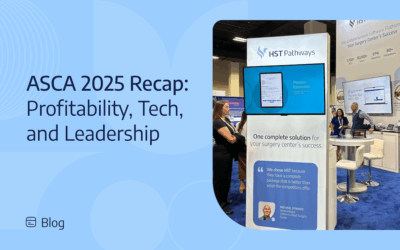Your Guide to Choosing ASC EMR Software
Choose the Right Type of EMR Software for Your ASC
Here are some examples:
Physician: Allscripts, eCW, Nextgen, etc.
Hospital: EPIC, Cerner
ASC Specific: HST’s electronic charting, SIS
When evaluating ASC EMR software vendors, here is a checklist of questions to ask:
- Is it built specifically for the Ambulatory Surgery Center (ASC) market?
- Is it repurposed from different healthcare EMR users like a hospital?
- Does it contain all the necessary surgery center industry-specific and required reports?
- How often is the software updated?
- Does the software company have a client product council focused on surgery center EMR needs?
- Can I speak with current ASC customers?
- Is this the best ASC EMR software for my business?
Remember the Goldilocks Effect – you need to find an EHR that fits just right.
Identify Internal Stakeholders Important for Your ASC EMR Software Success
With internal buy-in from all necessary echarting stakeholders, it will be easier to make the ASC EMR evaluation, implementation, and adoption processes successful. It is important to understand everyone involved – from the person who has final approval to the person who will be living in the ASC chart day-in and day-out. Internal evangelists and influencers are critical to successful ASC electronic charting implementation and adoption. Consider this group your ambulatory EMR committee.
Let’s build your ASC EMR software committee. Start with these questions:
- Who be in charge of gathering and presenting research on different top ambulatory EHR vendors?
- Who will be part of evaluating the ambulatory EHR market research? Potentially members of your staff that have previously used echarting benefits or keep up with ASC electronic charting industry trends.
- Who will be the echarting end-users? (Nurses, physicians, administrators, etc.)
- Who will be making the ultimate ambulatory care EHR software product decision?
Here’s how you can make your Ambulatory EHR committee a success.
- Establish a realistic and achievable surgery center EMR implementation timeline.
- Establish recurring meetings to discuss the ASC EMR decision and progress.
- Be open to new ideas that could lead to echarting benefits.
- Foster creativity.
- Embrace change to facilitate surgery center growth.
- Develop a mission for your ambulatory surgical center ehr team.
- Be transparent and forthcoming about ASC goals.
Establish a Baseline for Your ASC EMR Software
To make this a success, you must take the time to do a thorough analysis of how your ASC is operating today. By doing so, you’ll be able to identify holes in your processes and where there is room for improvement, helping build your case for moving forward with an ambulatory surgery center EHR. Without this foundation, it will be challenging to get your stakeholders on board with implementing an ambulatory care EHR software product and answer any questions that may come up. It will also be necessary as you build the case for executive or board-level approval.
Understand what is currently working or not working in your charting processes by asking the following:
-
- Look at all areas of your internal processes – from scheduling to paper charting to payments.
- What do the internal stakeholders like and dislike about paper charting? What do they like vs. what can be improved?
- What do the external stakeholders like and dislike? Speak with your Physician’s Offices, Anesthesia Providers, Vendors, etc.
- Gather all your ASC charts, begin an internal evaluation of the chart(s) and determine what changes are desired.
- Look for areas of friction, when and where are you handling paper ASC charts?
Identify areas for opportunity and efficiency in your charting systems by asking:
-
-
- How does information currently flow into and out of the ambulatory surgery center?
- What can you change?
- What do you want to change?
- What do you need to change?
-
Understand your ASC’s specific needs:
-
- Perform a gap analysis of your ASC charting process.
- Identify your programmatic processes.
- Identify interface options and needs.
Identify the technology to support your needs including:
Hardware
- What currently exists? (laptops, workstations, tablets, etc.)
- What needs to be purchased?
- How many items need to be bought, and from where?
- Printers/Fax – what is compatible?
- Vital Monitors – what is compatible
Software
- What is included with the ASC EMR system?
- What is not included?
- How does this work with third-party software?
- Is third-party software necessary?
- Does it connect to towers, etc.?
Infrastructure
- What does your ASC need to build out?
- Evaluate wiring and wireless
- Look into your internet provider bandwidth and backup options.
Connect with Your Peers
There’s nothing more powerful than a referral from someone you trust who has implemented an ambulatory EMR solution. We recommend talking to as many people as possible to gather first-hand testimonials based on experience. You can connect with other local surgery centers, your state ASC association, check ASCA Digest or the ASCA Connect forum, listen to ASC podcasts, and find peers on LinkedIn to get the conversation started.
Some questions to ask your peers:
- Which EHR are you using?
- Which EHRs did you consider?
- How was the implementation process?
- What are the pros and cons?
- What surprises did you encounter?
- Did you miss anything during the selection process?
- Which questions do you wish you asked?
- Were there issues that came up? If so, what was the path for resolution?
- Would you choose the same EHR if you had to do it all again?
Select a Vendor
By now, you have put a great deal of time and energy into preparing for the ambulatory surgery center EMR selection process – so let’s do it!
Steps to take once you are ready to start the selection process:
- Identify the best ASC EMR vendors you want to receive more information from.
- Consider creating a Request for Proposal (RFP) or questionnaire based on your desired echarting benefits.
- Put a timeline in place for selecting the best ASC EMR for your surgery center.
- Double-check on your ambulatory EHR market selection committee – who will participate in the selection process?
- Determine how many ambulatory EHR vendor demonstrations you need. Will they be in-person or online?
- Determine ASC electronic charting features that are critical vs. important vs. nice to have (no software is 100%)
Questions to ask during the demonstrations:
- Am I seeing the ambulatory surgery center EMR application in real-time, or is it a video?
- What features are working today vs. what is coming soon?
- How often do you perform updates?
- How often do you perform EMR software updates?
- Who are your partners?
- Who do you integrate with?
- Can you tell me about your security measures?
- Can I see your ambulatory EMR implementation process?
- Can I speak with other ASCs currently going through the implementation process?
- Do you offer custom reporting and state reporting? Can I add new reports?
- How customizable is the ASC EMR system?
- What does customer support look like?
- What is your average response time, and do you offer a ticketing system?
- Will I have a dedicated point of contact throughout implementation and post-go-live?
- What continuing education do you offer post-implementation?
- Walk me through the pricing – what exactly is included? Will there be any surprises?
Start the Surgery Center EMR Implementation Process
The ambulatory surgery center EMR implementation process should be well-defined with no surprises. Your ambulatory EHR vendor should provide transparent, realistic dates and milestones you can expect to hit.
You should expect the following things for a successful ambulatory surgery center EMR implementation.
- A kick-off call with all stakeholders on both sides.
- An implementation project plan discussed and agreed upon during kick-off.
- A dedicated registered nurse on your staff who supports as the center’s expert for clinical processes.
- A standing, recurring meeting, either weekly or bi-weekly.
- Encouraged involvement from the various stakeholders and vendors.
- Clear expectations of the workload for each party (what they do vs. what you do).
- A detailed discussion around data conversion and additional costs regarding delays (on both parties).
Kick-off Go-Live
This is where the “rubber meets the road.” The go live of an ASC EMR solution should be planned and carefully executed, never a guess! This is the culmination of the work and investment from your team. There should be a test of the asc electronic charting process followed by a soft go-live (a test run) and the actual go-live (fully turned on). Contingency plans should be in place; however, the team should be well trained and excited to move forward using the ASC EMR software.
Here are some items to confirm:
- Is there a soft go-live to test the environment?
- What are the resources available during go-live?
- Is there a contingency plan if there are issues during go-live?
- Are there means to stagger go-lives if we are launching multiple products?
- How long does post-go-live support last?
Ongoing Education, Training, and Support
Success using a new ASC software solution is never a one-time thing. Moreover, using new software is an everyday thing. What happens after going live is as important as the go-live itself. You want a close partnership with your ambulatory EHR vendor and a path to continue improving your team’s knowledge. Equally important is a tool to provide and share feedback and suggestions. Consider this more of a partnership than a client-vendor relationship.
Here’s what you should be looking for:
- Continued education and training: free and paid options.
- Access to additional resources, webinars, user conferences, etc.
- Client portal for feedback, enhancement requests, and performance improvement ideas.
Let’s Summarize What You’ve Learned
In conclusion, understanding the different ambulatory electronic health record solutions available today is crucial for ambulatory surgery centers looking to implement a system that fits their center’s needs. ASCs should avoid EHR solutions designed for hospitals or physician offices and instead opt for an ambulatory surgery center EMR designed specifically for them.
When evaluating ASC EMR software vendors, some tips to remember include:
- It’s important to ask questions about market specificity, user benefits, required CMS or state reports, software updates, client implementation, and ongoing support.
- Forming an internal committee with clear roles and responsibilities is essential to a successful EHR implementation plan.
- Conducting internal due diligence and establishing a baseline for current ASC operations and processes helps identify areas for improvement for your new EMR system.
- Seeking referrals and advice from peers who have implemented ambulatory EMR solutions can provide valuable insights and testimonials.
Selecting the right vendor requires careful consideration, including creating a timeline, forming a selection committee, and conducting demonstrations to assess critical features, security measures, support, and pricing. The ASC EMR implementation process should involve clear project plans, stakeholder involvement, data conversion discussions, and a well-executed go-live strategy. Ongoing education, training, and support from the ambulatory EHR vendor are essential for long-term success, including access to resources, feedback channels, and a collaborative partnership.
Will switching to electronic charting make financial sense? 💰 Try our calculator to effortlessly determine your ROI over a three-year period.
Surgery centers that use HST’s electronic charting
are seeing big results:
50%
Reduction in time spent on chart preparation
30%
60%
80%
75%
75%
All data points were collected and aggregated by a verified third-party.
ASCA 2025 Recap: Profitability, Tech, and Leadership
ASCA’s Annual Conference, held on April 30th-May 3rd in Colorado, brought together thousands of industry leaders, vendors, and administrators to share insights, tackle challenges, and explore what’s...
Improving Profitability: Automating Claim Adjudication
Ep. 112: Melanie Howitt – Improving Profitability: Automating Claim AdjudicationHere's what to expect on this week's episode. 🎙️ In this week’s episode, Melanie Howitt, Transition &...
A Comprehensive Look at ASC Data from 2024
Ep. 111: A Comprehensive Look at ASC Data from 2024Here's what to expect on this week's episode. 🎙️ HST CEO David Thawley recently joined ASCA’s podcast, Advancing Surgical Care, to discuss key data...
1,600+
customers
70,000+
users
50M
cases documented
97%
customer retention



